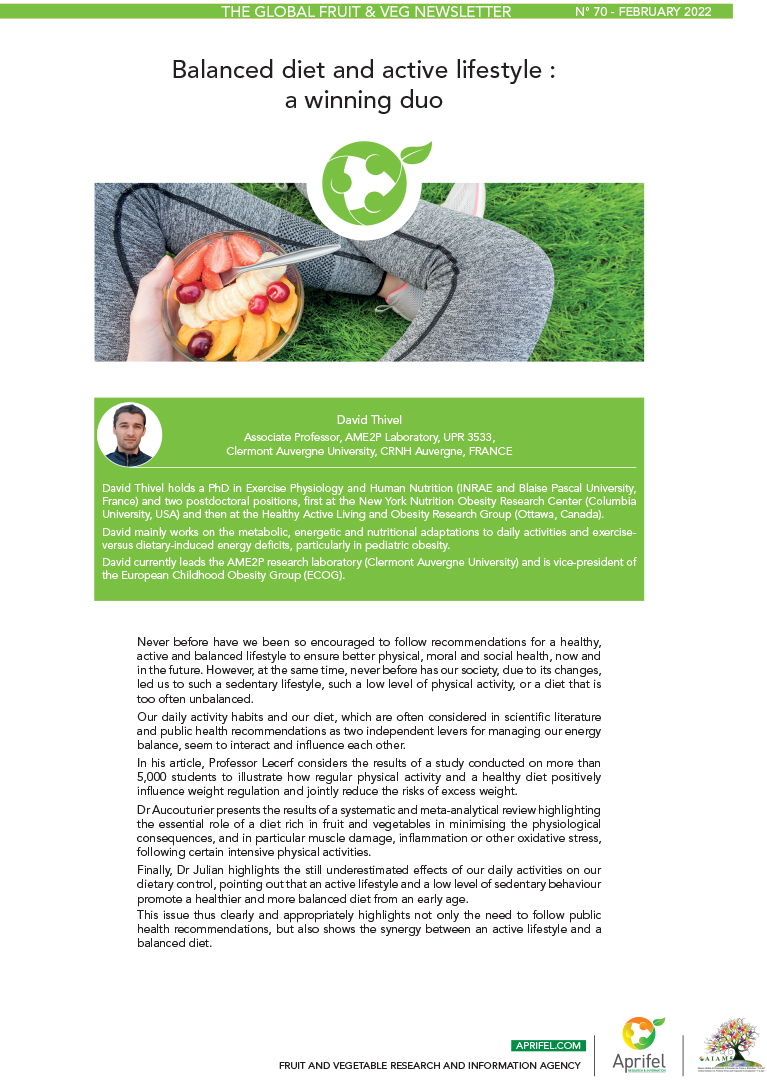Diet and physical activity of Brazilian students

Unhealthy lifestyles combining a lack of physical activity and poor dietary habits are considered to be the main risk factor for chronic diseases and premature death. Exposure to these risk factors related to overweight emerges strongly as of the second and third decades of life. This is the age when independence begins, including addictive experiences, peer influence, new eating habits, exposure to screens and sedentary lifestyles, and even the cessation of sport due to studies or work.
The aim of this study was to identify both sports practices and fruit and vegetable consumption among students at the Federal Technological University of Paraná in southern Brazil, which has more than 30,000 students.
Characteristics of the study population and their sports practices
5,310 students (boys 61.8% – girls 38.2%) were surveyed :
- 29.1% were 20 years old or younger,
- 39.1% were 21 – 25 years old, and
- 31.8% were 26 years old and over.
In terms of their health status, 28.9% were overweight (boys 35.5%, girls 18.2%) and 10.2% were obese (boys 12.1%, girls 7%), i.e., a total of 39.1% were overweight or obese, which is very high for these age groups.
With regard to sports activities, 19.6% reported that they did not practise any aerobic sports, while 29.9% practised aerobic sports one or two days a week. Furthermore, 26.4% practised aerobic physical activity 3 to 4 days a week and 24.1% at least 5 days a week. The percentage of students not doing any sport was 56.2% among those with obesity. As regards strength sports (exercising against resistance), 48.4% had never practised them, with this percentage reaching 76.9% in obese students.
Consumption of fruit and vegetables well below dietary recommendations
A total of 14.5% never consumed fruit and vegetables (19.6% of boys and 6.2% of girls), 51.8% had a low consumption, 20.7% a moderate consumption and only 13.0% an adequate consumption, i.e., more than 5 servings per day. A total of 7.9% of boys and 21.2% of girls had a high consumption of fruit and vegetables.
It is interesting to note that the lack of consumption decreases sharply according to the three age groups (23.5%, 16.9% and 4.7%), according to marital status (16.6% single – 7.1% in a couple) and increases with the course year (from 10.4% to 16.4%) and sharply with increasing weight (10.7%, 18.1% and 29.7%).
Conversely, the percentage of students with adequate or high consumption decreases with increasing weight (17.9%, 6.9% and 5.8%), as does the percentage with moderate consumption (27.3%, 11.1% and 9.2%).
Lower fruit and vegetable consumption strongly associated with obesity risk
The authors were able to calculate an Odds Ratio (OR) of the risk of obesity and overweight by gender for types of physical activity and for fruit and vegetable consumption. In girls the OR was 1.00 for at least 5 fruit and vegetables/day, 1.43 for 3 – 4 servings/day, 1.97 for 1 – 2 servings/day and 2.92 for 0 servings. For boys the figures were 1.26, 1.54 and 1.98 respectively with in both cases a p<0.001 after adjustment for age, marital status and year of study.
Thus, fruit and vegetable consumption among students is modulated by socio-demographic factors. Lower consumption is strongly linked with the risk of obesity.
Based on: Guedes DP, Silva ALDS. Exercise and fruit/vegetable intake, and their associations with body weight status in university students Nutr Hosp. 2021 Jun 10;38(3):545-554.
- Students are often exposed to a flawed lifestyle (diet, physical activity)
- Physical activity is very insufficient for one student out of five, but more than half are obese
- Only 13% of them have an adequate fruit and vegetables consumption
- A low consumption of fruit and vegetables multiplies by two (boys) or three (girls) the obesity risk
- Actions must be taken to improve their life habits

